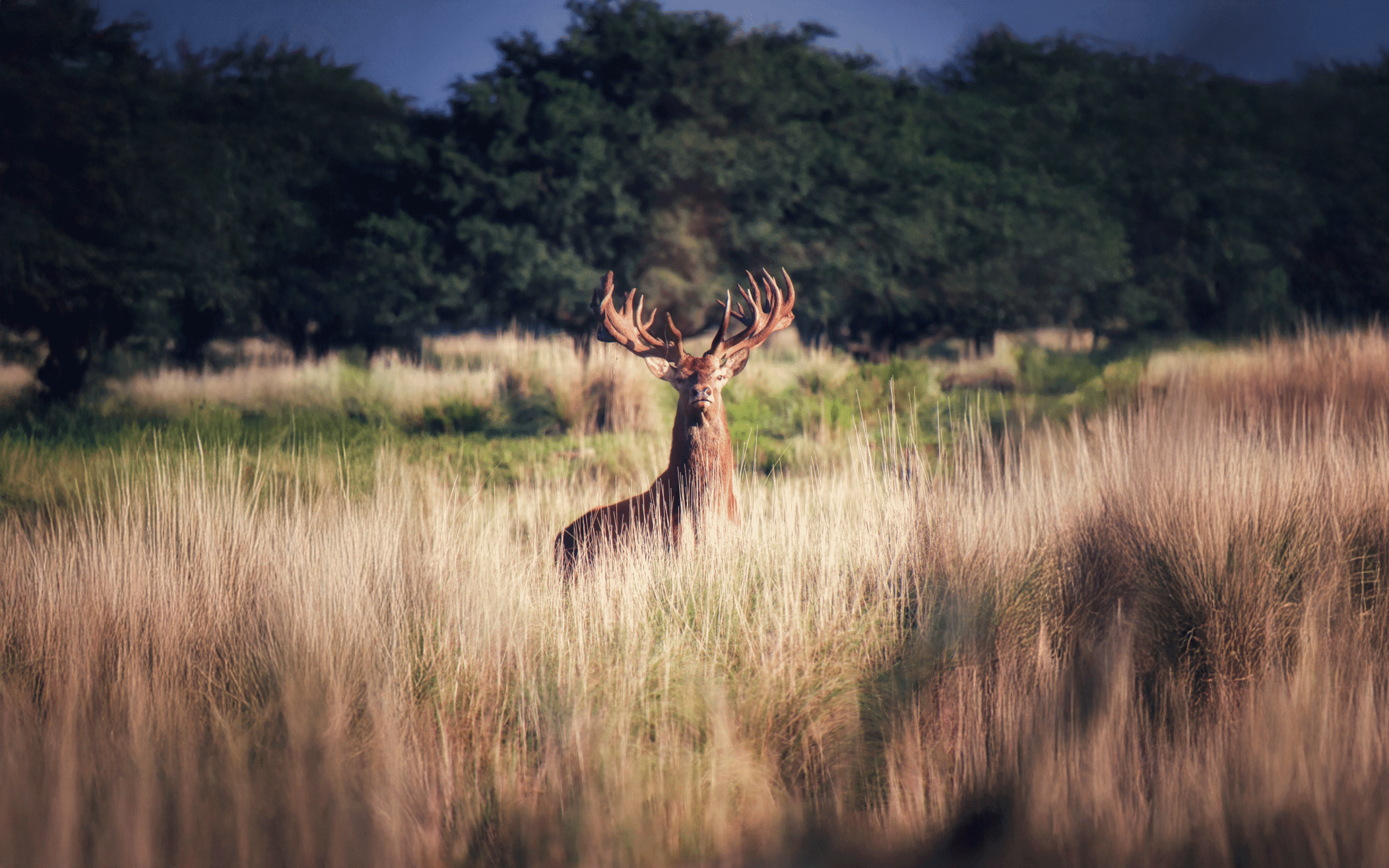Picture this: a 500-pound monarch of the forest, crowned with antlers spanning four feet, releasing a primal roar that echoes across misty valleys. This is the red stag—nature’s most impressive deer and a creature that has captivated humans for over 40,000 years.
A red stag is a male red deer (Cervus elaphus), one of the world’s largest deer species. These magnificent animals typically weigh 350-530 pounds and stand 48-51 inches tall at the shoulder. What makes them truly remarkable? Their branched antlers can span up to 45 inches, and they shed and regrow them completely every single year—one of nature’s most incredible regeneration feats.
Native to Europe, Asia, and North Africa, the European red deer represents the most widespread subspecies across the continent. But here’s what’s fascinating: red deer have conquered new worlds. Today, they thrive in Argentina, New Zealand, Australia, and North America, where male deer (stags) command premium prices as trophy animals and produce sought-after venison. In modern times, the red stag remains a symbol of wilderness, a conservation success story, and an economic powerhouse for rural communities worldwide.
Quick Facts: Red Deer (Cervus elaphus) at a Glance
| Characteristic | Details |
|---|---|
| Scientific Name | Cervus elaphus |
| Average Male Weight | 350-530 lbs (160-240 kg) |
| Average Female Weight | 260-370 lbs (120-170 kg) |
| Shoulder Height | 37-51 inches (95-130 cm) |
| Antler Span | Up to 45 inches (115 cm) |
| Top Speed | 45-50 mph (70-80 km/h) |
| Lifespan (Wild) | 10-13 years |
| Lifespan (Captivity) | 15-20 years |
| Gestation Period | 240-262 days |
| Global Population | 15-20 million deer |
What Is a Red Stag?
Ever wondered about the difference between “red deer” and “red stag”? It’s simpler than you might think. Red deer refers to the entire species of Cervus elaphus—the fourth-largest deer species globally. They’re only surpassed in size by moose, elk (wapiti), and sambar deer. A red stag, on the other hand, specifically means a mature male red deer.
Here’s how to tell them apart at a glance. Males (stags) sport those iconic branching antlers and have significantly larger, more muscular bodies. Females (hinds) lack antlers entirely and are generally 25-30% smaller—but don’t underestimate them. They’re the ones who lead the herds and make most of the survival decisions.
Key Red Deer Terminology:
- Stag/Hart: Adult male red deer
- Hind/Doe: Adult female red deer (the matriarchs who keep herds together)
- Calf/Fawn: Young red deer of either sex, born with spotted coats that provide perfect forest camouflage
- Spiker: Young male deer with simple, unbranched antlers (think teenager with his first attempt at antlers)
- Hummel: Male deer that never grows antlers due to a rare genetic condition
Physical Characteristics of Red Deer: Stags vs Hinds
Size and Weight
Red deer showcase nature’s adaptability through their incredible size variations. Depending on their habitat and subspecies, these animals can range from relatively modest to absolutely massive. This isn’t just random variation—it’s evolution in action.
Consider this: some large North American elk (their closest cousins) can match the biggest European red deer in size. Both species evolved from common ancestors but adapted to different continents and challenges.
Male Red Deer (Stags):
- Standard Range: 350-530 pounds (160-240 kg)
- Exceptional Specimens: Up to 750 pounds (340 kg)
- Shoulder Height: 37-51 inches (95-130 cm)
Female Red Deer (Hinds):
- Weight: 260-370 pounds (120-170 kg)
- Shoulder Height: 33-45 inches (85-114 cm)
Where do the giants live? The Carpathian Mountains of Central Europe produce the largest specimens. Why? Perfect genetics meet abundant food in an ideal climate. It’s like a bodybuilder’s paradise for deer.
After the rut (mating season), something interesting happens. Females and their young form large herds—sometimes numbering in the hundreds. It’s their strategy for protection and passing down survival knowledge through generations.
Red Deer Antler Development and Growth
Ready for some mind-blowing facts? Red stag antlers grow up to one inch per day during peak summer growth. That’s faster than bamboo! These aren’t just decorations—they’re 11-pound weapons that can span 45 inches in exceptional males.
But here’s the real kicker: stags shed these massive antlers every single year and grow them back from scratch. Imagine growing and discarding a piece of bone the size of a small tree annually. It’s one of nature’s most energy-intensive processes.
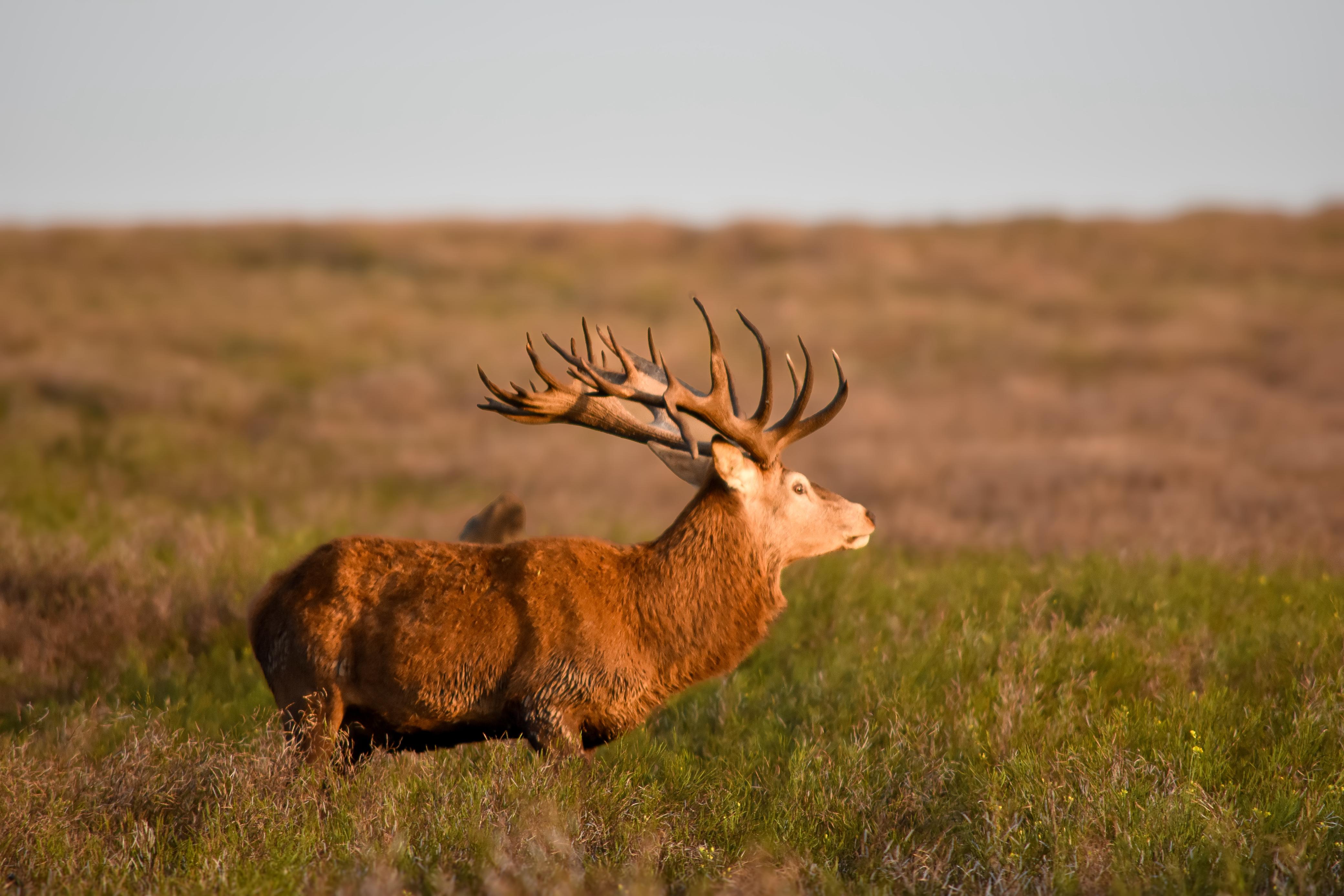
Antler Development Timeline in Red Deer:
- March-May: Previous year’s antlers fall off (casting)
- May-August: New antlers grow covered in “velvet”—a fuzzy, blood-rich skin that nourishes the growing bone
- August-September: Velvet dries and peels off, revealing hard antler underneath
- September-March: Hard antlers used for fighting and display during breeding season
What’s that distinctive “crown” you see on mature stags? Multiple tines sprouting from the antler’s end, like a natural crown. This royal headgear typically appears when male deer reach 6-8 years old—their prime years.
And yes, those antler battles you’ve seen in documentaries? They’re real and brutal. Rival stags lock antlers and push with tremendous force. Serious injuries happen. Sometimes, antlers become so entangled that both stags die. Nature doesn’t mess around.
Red Stag vs Other Deer Species
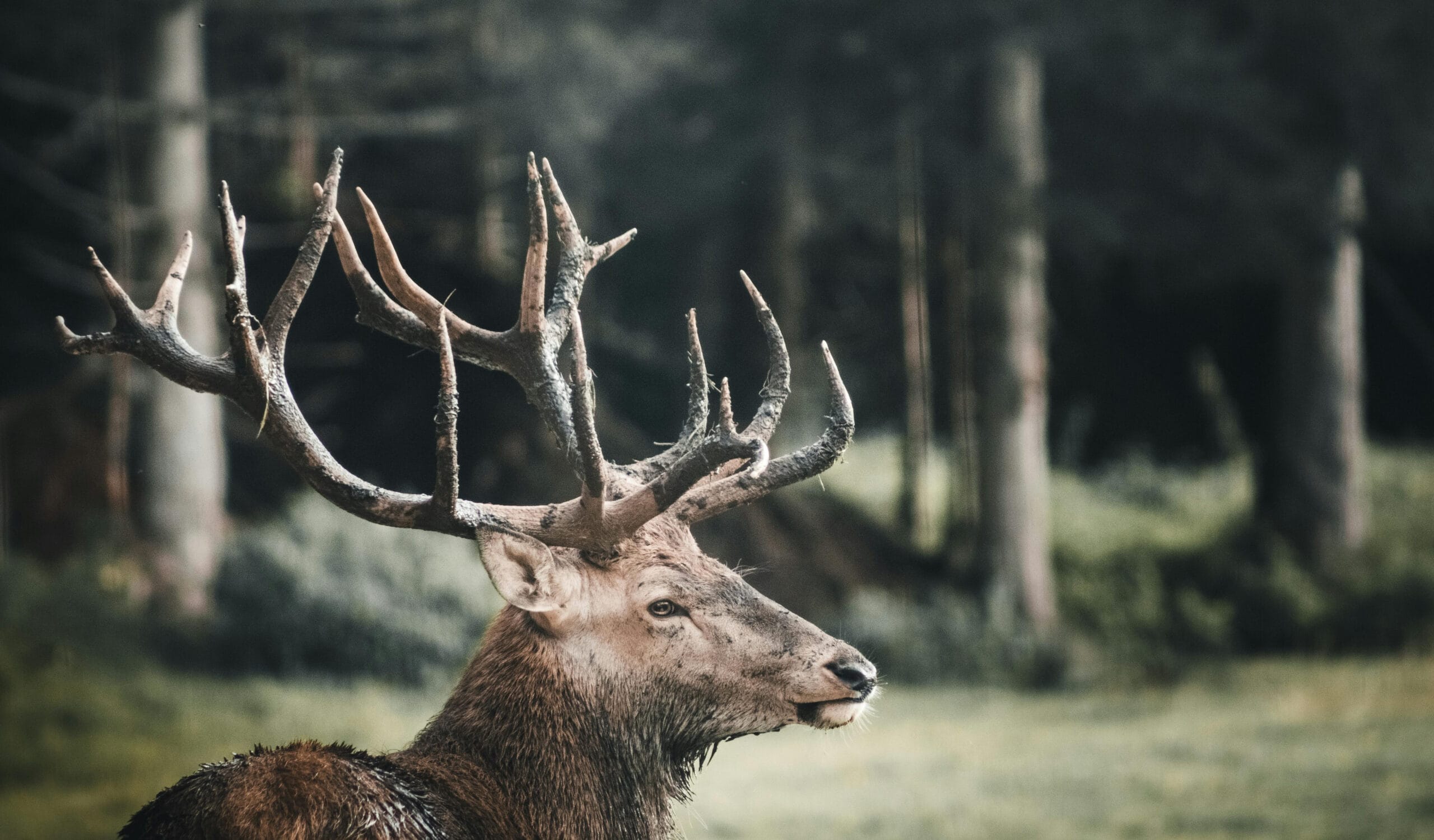
Red Deer vs Whitetail Deer
| Feature | Red Stag | Whitetail Deer |
|---|---|---|
| Weight | 350-530 lbs | 150-300 lbs |
| Height | 37-51 inches | 32-40 inches |
| Antlers | Complex branched crowns | Simple bifurcated beams |
| Habitat | Open woodlands | Dense forests |
| Distribution | Old World native | New World native |
Red deer are nearly twice the size of large whitetails. They evolved as one of the largest and most majestic animals in their ecosystems. While adult red deer face few natural predators today, young deer must still watch out for foxes and golden eagles—a reminder that even giants start small.
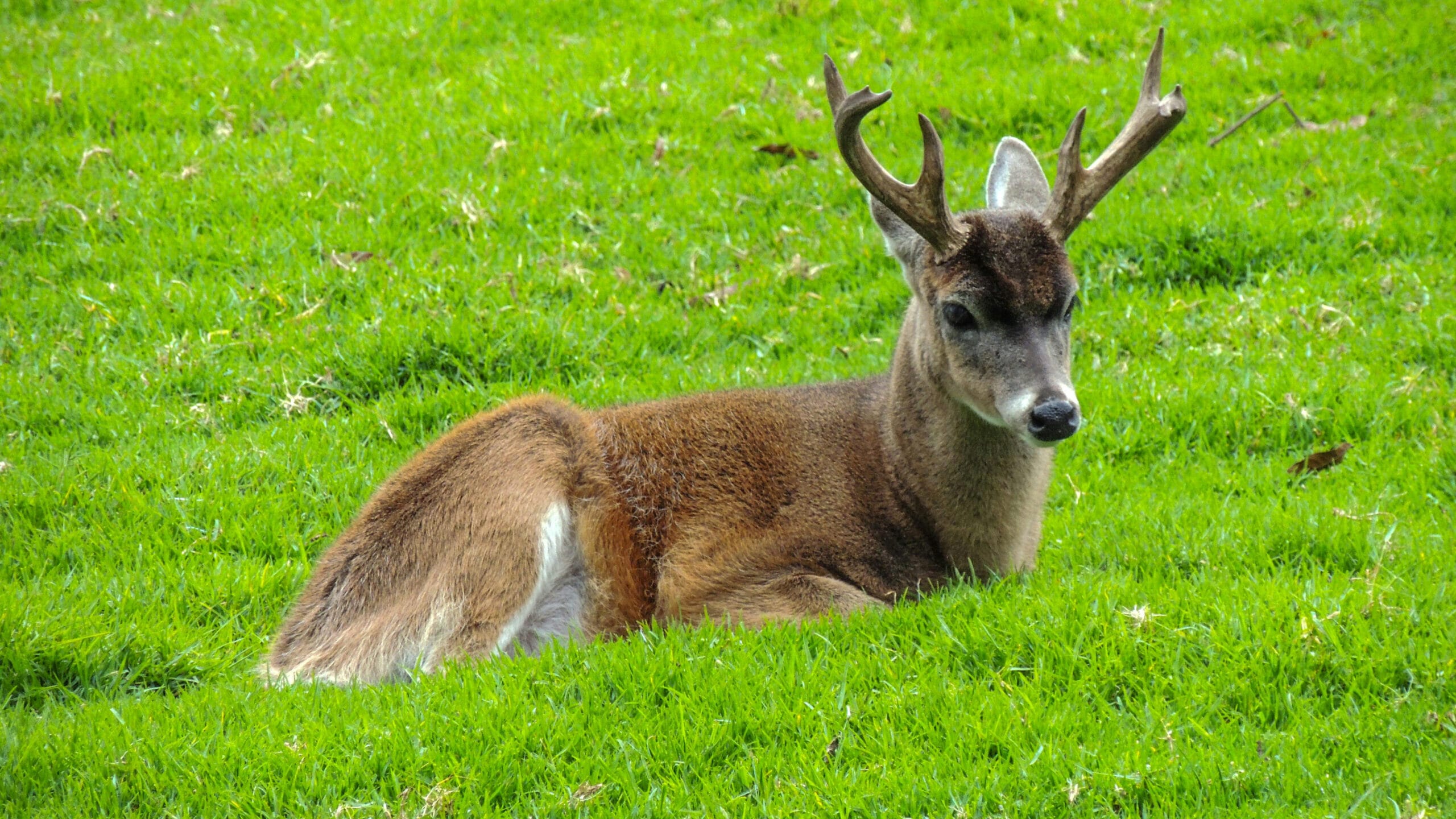
Red Deer Habitat and Global Distribution
Native Range
Red deer are true world travelers, naturally inhabiting three continents. Their adaptability to different climates and terrains explains their evolutionary success.
Europe remains their stronghold:
- Scotland: The Scottish Highlands host iconic populations and centuries-old stalking traditions
- Continental Europe: Norway, Germany, Poland, Romania, Spain
- Each country’s red deer adapted to local conditions, creating distinct subspecies
Asia’s populations stretch across:
- Turkey, Iran, Kazakhstan
- The vast Caucasus region
- Each area contributing unique genetic diversity
Even Africa has red deer! The Atlas Mountains (Morocco, Tunisia, Algeria) host the Barbary stag—the only deer species native to Africa. How’s that for breaking stereotypes?
Introduced Red Deer Populations
Here’s where the story gets interesting. Human ambition spread red deer across the globe, creating some of the world’s most successful wildlife introductions.
The Southern Hemisphere became their new kingdom. Argentina alone maintains over 100,000 free-range animals—more than many European countries! New Zealand transformed into a red deer paradise. Australia and Chile developed thriving populations. Even North America, with its native elk, embraced managed red deer herds on hunting ranches.
Why such success? In places like New Zealand and Argentina, red deer found perfect conditions without their traditional predators. Deer farms and hunting ranches now play crucial roles in these countries’ economies. They provide hunting opportunities while supporting habitat conservation—proof that wildlife and commerce can coexist.
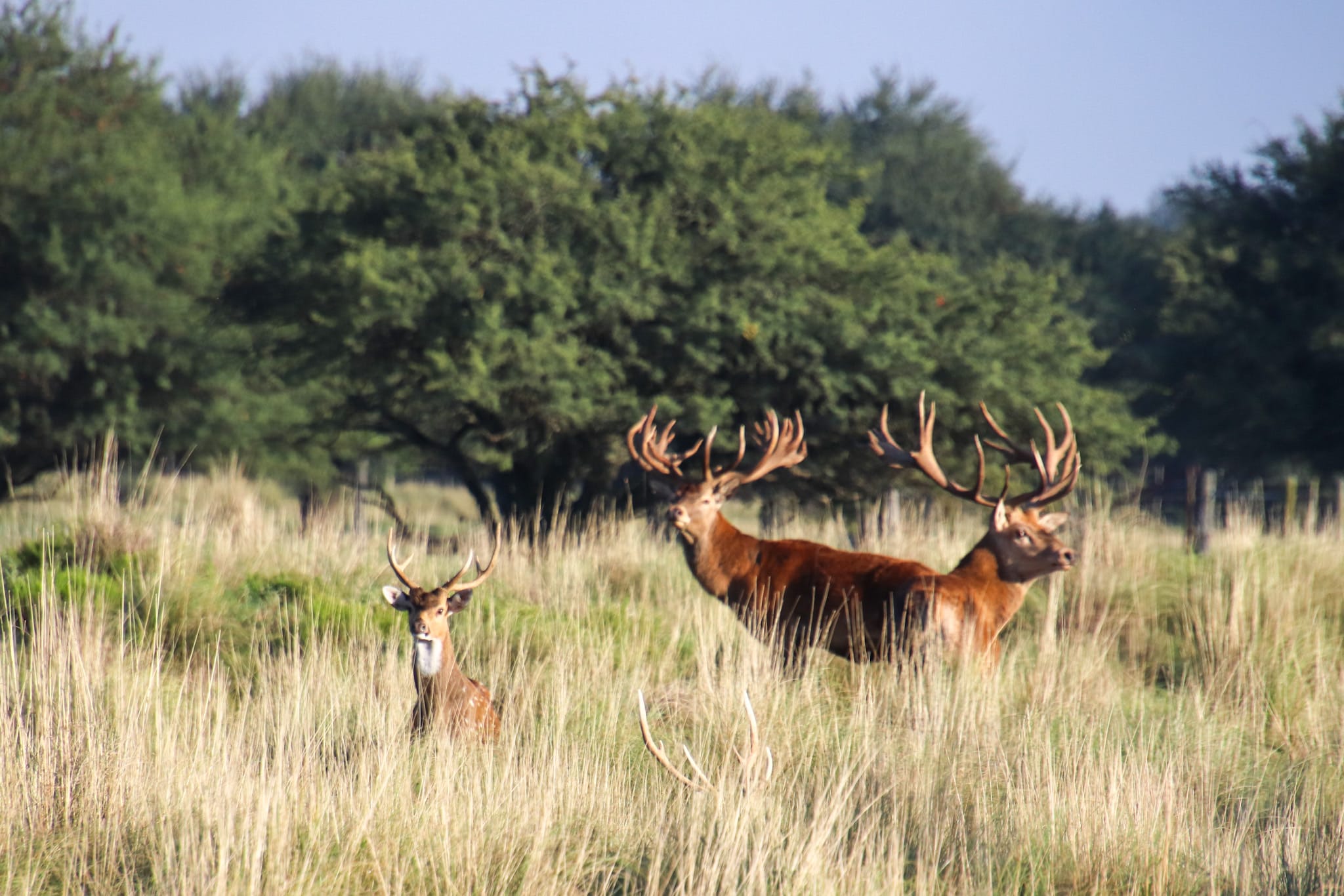
Red Deer Diet and Feeding Behavior
Think red deer are just grass-eaters? Think again. These adaptable feeders change their menu with the seasons like natural gourmets.
Red deer are “intermediate feeders”—a fancy way of saying they’re not picky. They graze like cattle when grass is lush. They browse like goats when trees offer tender shoots. This flexibility is their superpower.
Seasonal Diet of Red Deer:
- Spring: Fresh grass shoots, tree buds, high-protein plants (like a detox diet after winter)
- Summer: Mature grasses, wildflowers, agricultural crops (the salad bar is open!)
- Autumn: Acorns, nuts, corn—high-calorie foods for winter prep
- Winter: Tree bark, evergreen needles, dried grasses (survival mode activated)
Daily consumption? A whopping 15-20 pounds of vegetation. That’s like eating 60-80 hamburgers worth of plant matter every single day!
Red Deer Mating Season: The Rut Explained
Imagine the forest suddenly erupting with deep, guttural roars that shake the morning mist. Welcome to the rut—nature’s most dramatic dating scene.
The rut transforms peaceful stags into hormone-fueled warriors. They stop eating, lose 20-25% of their body weight, and think about only one thing: winning females. It’s like the ultimate extreme sport, but the prize is genetic immortality.
Red Deer Rutting Season by Region:
| Location | Peak Rut | Season |
|---|---|---|
| Scotland/Europe | September-October | Autumn |
| Argentina/Chile | March-April | Autumn |
| New Zealand | March-May | Autumn |
| Texas (Introduced) | Variable | Year-round possible |
What happens during the rut? Pure theater:
- The Roar: Stags produce deep, resonating bellows lasting 3-5 seconds. Each roar says “I’m big, I’m strong, stay away or fight me!”
- Antler Displays: Visual intimidation—like flexing at the gym but with bone weapons
- Fighting: When intimidation fails, stags lock antlers in violent shoving matches
- Harem Gathering: Winners collect 5-20 females while exhausted losers retreat
Here’s the brutal truth: mature stags compete so fiercely with other males that some die from exhaustion or injuries. Evolution doesn’t guarantee survival—it only rewards the strongest genes.
Antler Scoring Systems for Red Deer
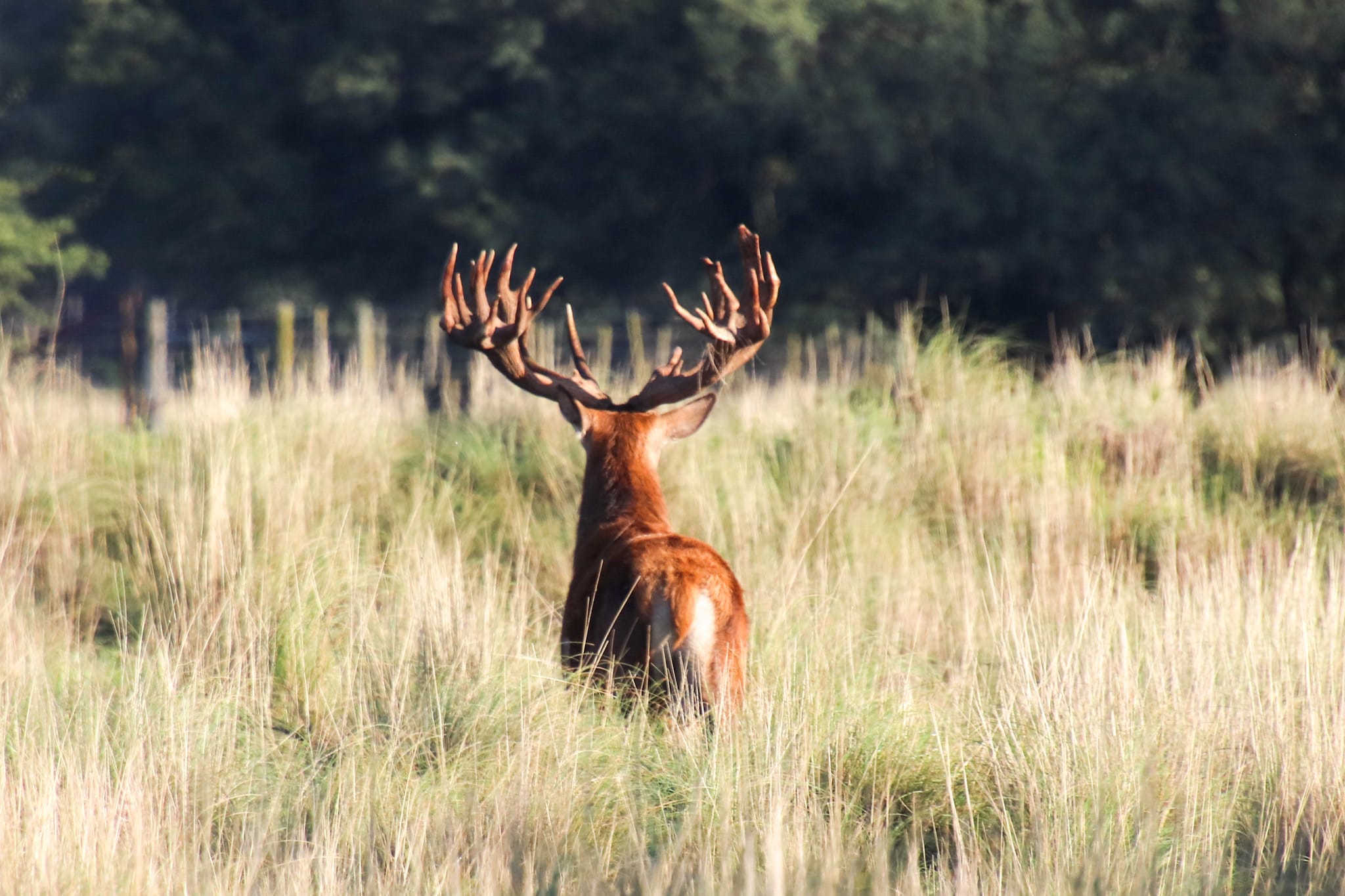
How do you measure magnificence? The hunting world uses two main systems, each reflecting different philosophies about what makes a perfect trophy.
Safari Club International (SCI)
Think of SCI as the “bigger is better” approach. Popular in the Americas and Oceania, it simply measures total antler inches. No deductions for asymmetry—just pure, impressive size.
Medal Categories:
- Bronze: 190-290 inches
- Silver: 291-377 inches
- Gold: 450+ inches
- World Record: 1,000+ inches (New Zealand red deer)
Yes, you read that right—over 1,000 inches of antler! New Zealand’s managed herds produce monsters that would make their wild ancestors look like dwarfs.
CIC (International Council for Game and Wildlife Conservation)
Europe’s traditional system values balance and beauty alongside size. It’s like comparing a bodybuilding contest (SCI) to a classical sculpture competition (CIC).
Medal Categories:
- Bronze: 165.00-184.99 points
- Silver: 185.00-199.99 points
- Gold: 200.00+ points
- World Record: 273.60 points (Bulgarian red deer)
The philosophical difference? SCI celebrates human management’s ability to produce giants. CIC honors nature’s ability to create perfection.
Red Deer Populations Worldwide
Here’s a conservation paradox: red deer thrive globally while some subspecies teeter on extinction’s edge. How can both be true?
The answer lies in location, location, location. While 15-20 million red deer roam the planet, their distribution tells a complex story. Native European and Asian populations remain stable at 3-5 million. But introduced populations exploded to 12-15 million—especially in places like Argentina.
During their vulnerable first few months, red deer calves face a harsh reality. Only about 50% survive their first winter in harsh climates. This natural selection maintains healthy, resilient populations.
Argentina: A Century of Conservation Success
Let me tell you a story that sounds too good to be true. In 1906, Pedro Luro brought a handful of red deer to Argentina’s La Pampa region. His selection wasn’t random—he chose premium bloodlines from the Carpathian Mountains, home to Europe’s largest deer.
Fast forward a century. Those few dozen deer became 100,000+ free-ranging animals. But this isn’t just about numbers. It’s about creating something unprecedented.
What makes Argentina special for red deer?
- Genetic lottery winners: Original breeding stock from Europe’s finest estates
- Space to roam: Estancias exceeding 60,000 acres with no fences
- Perfect habitat match: Patagonian landscapes mirror their European homeland
- No natural predators: Pumas exist but aren’t deer specialists
- Cultural integration: Gaucho horseback hunting became a cherished tradition
The result? Argentine red deer now match or exceed their European ancestors in size. Nature and human selection combined to create exceptional animals. It’s evolution on fast-forward, proving that wildlife introductions aren’t always ecological disasters.
This success brings responsibility. Argentina now manages one of the world’s most important red deer populations—a genetic reservoir for the species’ future.
Red Deer Conservation Status
Good news in conservation is rare, so let’s celebrate: red deer are thriving. With 15-20 million individuals worldwide, they’re classified as “Least Concern” globally. Populations are stable or increasing across most of their range.
But (there’s always a but in conservation), this success comes from active management, not luck.
Population Overview
- Global Population: 15-20 million red deer individuals
- Trend: Stable to increasing globally for deer populations
- Native Range: 3-5 million deer
- Introduced Range: 12-15 million deer thriving worldwide
Conservation Through Sustainable Management
Here’s what works:
- Economic Value: Stag hunting generates revenue that makes deer more valuable alive than their habitat is for development
- Population Control: Managed hunting prevents overgrazing and habitat destruction
- Revenue Generation: Fees fund conservation programs and research
- Rural Employment: Entire communities depend on deer-related tourism and hunting
It’s pragmatic conservation—protecting wildlife by making it economically valuable. Not everyone loves this approach, but it works.
Red Deer in Culture and History
Why do red deer appear in 40,000-year-old cave paintings? Because they’ve always mattered to humans. They’re not just animals—they’re symbols, stories, and sustenance rolled into one magnificent package.
Throughout history, red deer represented:
- Prehistoric survival: Meat, hide, tools from antlers
- Celtic spirituality: Forest gods and seasonal renewal
- Medieval nobility: Only aristocrats could hunt the “royal stag”
- Modern economics: Multi-million dollar hunting and tourism industries
Today’s red deer connect us to this ancient relationship. Whether you’re a photographer capturing their majesty, a hunter pursuing a trophy, or a hiker lucky enough to hear their roar, you’re part of a story stretching back to humanity’s dawn.
The red stag remains what it’s always been—wild nobility made flesh. In a world of constant change, these magnificent animals endure, adapt, and thrive. They remind us that nature, given space and respect, creates wonders beyond human imagination.
Next time you see those branching antlers silhouetted against the sky, remember: you’re looking at 40,000 years of shared history, millions of years of evolution, and one of Earth’s most successful large mammals. The red stag isn’t just surviving in our modern world—it’s conquering it, one majestic roar at a time.
Frequently Asked Questions About Red Stags and Red Deer
How much does a red stag weigh?
A mature male red deer (stag) typically weighs 350-530 pounds (160-240 kg), with exceptional deer specimens reaching 750 pounds. Female red deer (hinds) are smaller, weighing 260-370 pounds (120-170 kg).
What’s the difference between a red stag and an elk?
Red deer and elk are distinct deer species. Elk are significantly larger (600-1,000+ pounds vs 350-530 pounds), produce a high-pitched bugle instead of the red deer’s deep roar, and have longer, sweeping antlers rather than the compact crown formation of red deer.
When is red deer mating season?
In the Northern Hemisphere, red deer rut occurs September-October. In the Southern Hemisphere (Argentina, New Zealand), red deer mate during March-April. Texas offers year-round opportunities due to managed deer populations.
How big do red stag antlers get?
Red deer antlers can reach 45 inches in length and weigh up to 11 pounds per antler. Trophy scoring for these deer varies: SCI scores range from 190 inches (bronze) to over 1,000 inches (world record), while CIC scores range from 165 points (bronze) to 273+ points (world record).
Where do red deer live?
Red deer inhabit Europe, Asia, and North Africa naturally. Introduced deer populations thrive in Argentina (largest free-range), New Zealand, Australia, and the United States. Each region offers unique red deer viewing and conservation opportunities.
What do red deer eat?
Red deer are ruminants with seasonal diets: spring (new growth, buds), summer (grasses, forbs), autumn (acorns, nuts), and winter (browse, bark). These deer consume 15-20 pounds of vegetation daily.
How long do red deer live?
Red deer typically live 10-13 years in the wild and up to 20 years in captivity. Prime years for these deer occur between ages 5-12, with peak antler development in male deer at 8-10 years.
Are red stags dangerous?
Male red deer can be dangerous during rutting season (September-October in Northern Hemisphere, March-April in Southern) when testosterone peaks. Maintain 100+ yards distance from rutting deer and never approach these animals closely.
What is the red stag roar?
The roar is a deep, guttural vocalization lasting 3-5 seconds, unique to red deer and used to attract female deer and warn rival males during rut. Each stag has a distinctive roar that evolved for forested deer habitats.
How fast can red deer run?
Red deer can reach speeds of 45-50 mph (70-80 km/h) in short bursts and sustain 20-25 mph for several miles. These deer are excellent jumpers, clearing 8-foot obstacles, and strong swimmers.
What’s the best caliber for red stag hunting?
Effective calibers for red deer range from .270 Winchester to .375 H&H Magnum. Popular choices for these large deer include .30-06 Springfield, .300 Winchester Magnum, and 7mm Remington Magnum with 150-180 grain premium bullets.
Can you eat red deer meat?
Red deer venison is excellent table fare—lean, high in protein, and lower in fat than beef. Grain-fed or well-managed deer produce the finest venison. Proper field care and aging are crucial for optimal flavor from these deer.
When do red stags shed their antlers?
Male red deer shed antlers annually between March and May, triggered by declining testosterone. Older stags cast first. New growth begins immediately in these deer, taking 3-4 months to fully develop before the next rut.
What’s the difference between red deer and red stag?
“Red deer” refers to the entire deer species (Cervus elaphus) including both sexes. “Red stag” specifically means adult male deer. Female deer are called “hinds” or “does,” while young deer are “calves” or “fawns.”
Conclusion
The red stag stands as one of the most successful deer species in nature—a magnificent deer that has not only survived but thrived across six continents. From the misty highlands of Scotland to the vast grasslands of Patagonia, red deer continue to capture the imagination of wildlife enthusiasts, conservationists, and nature lovers alike.
Whether you’re studying these remarkable deer, planning wildlife viewing, or simply appreciating their role in our natural heritage, understanding red deer enriches our connection to the wild world. Their haunting roar echoing across autumn landscapes serves as a reminder that some of nature’s treasures—like these majestic deer—are worth preserving forever.
For those ready to witness red deer conservation success firsthand, explore Argentina’s thriving red deer populations, where sustainable management practices have created one of the world’s most remarkable wildlife stories.

